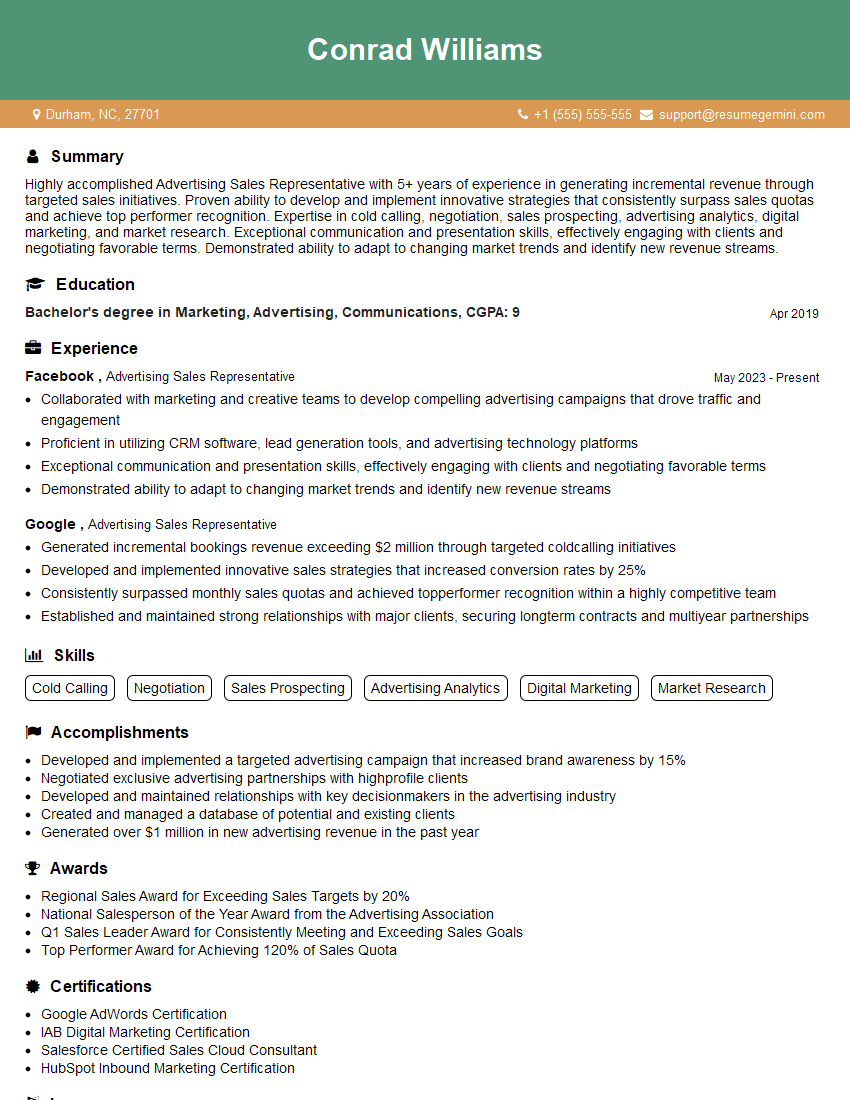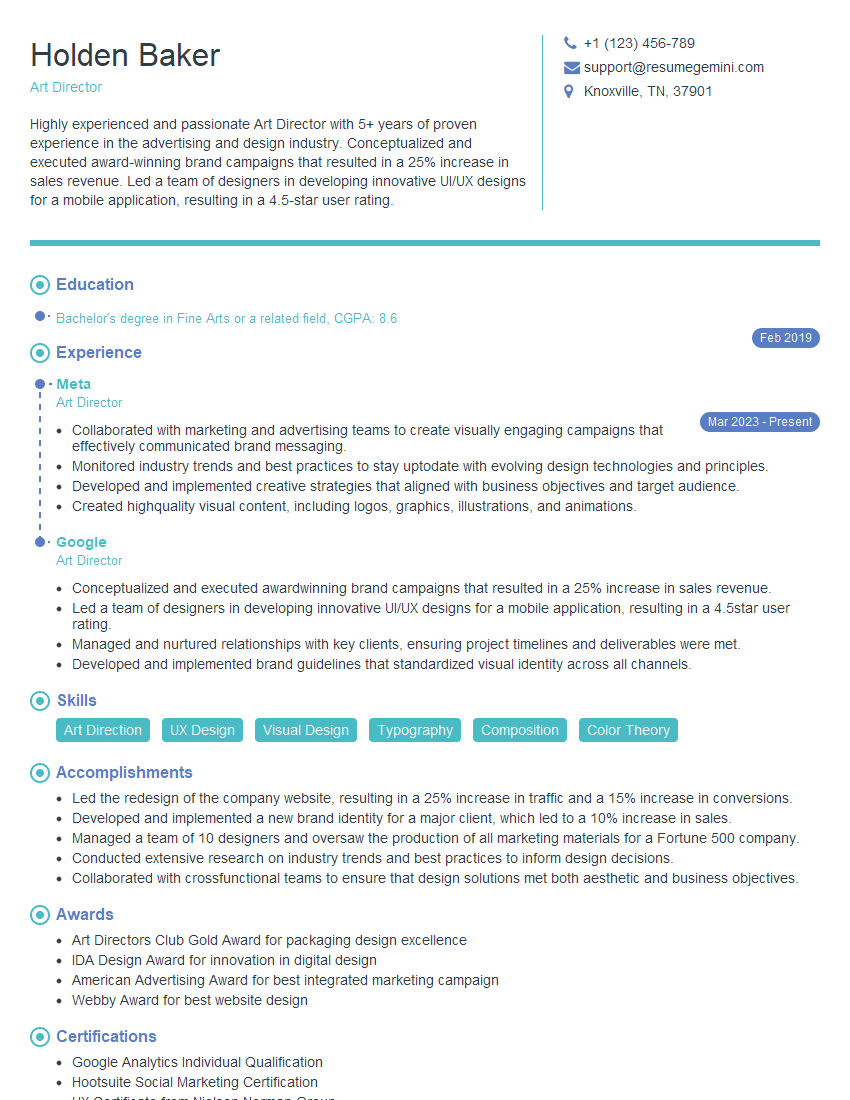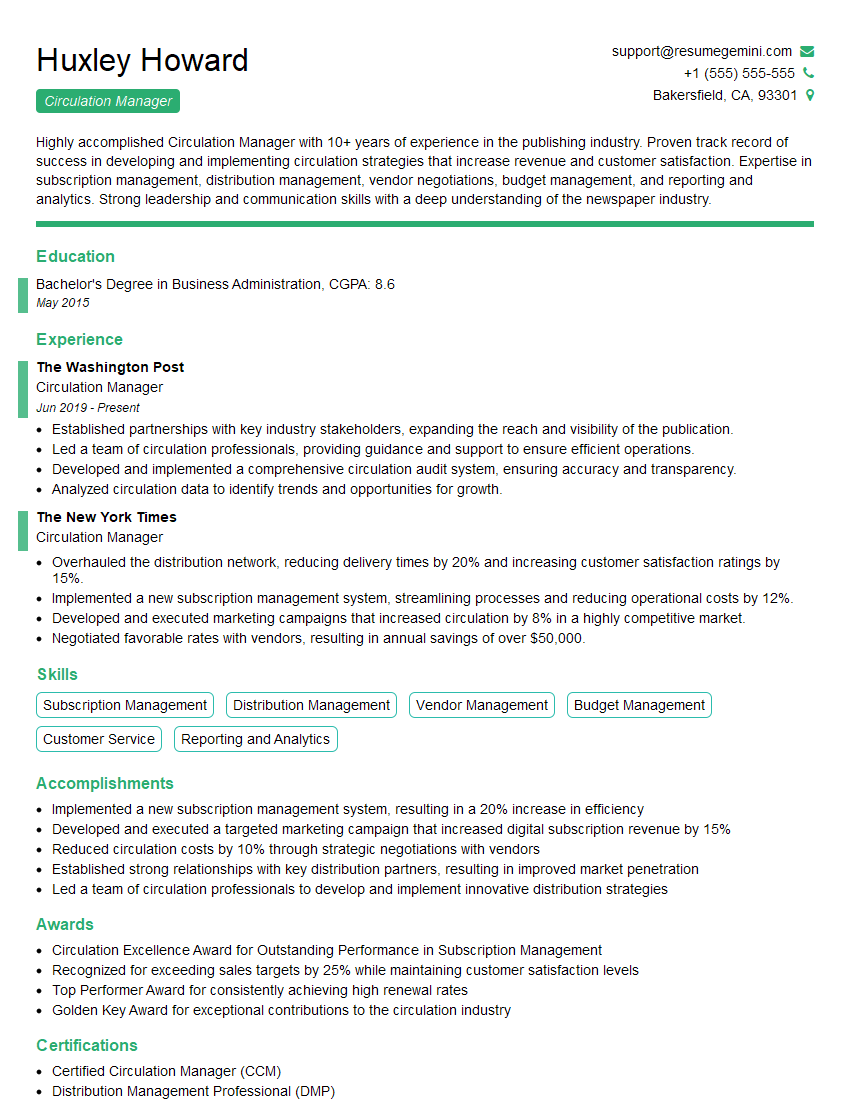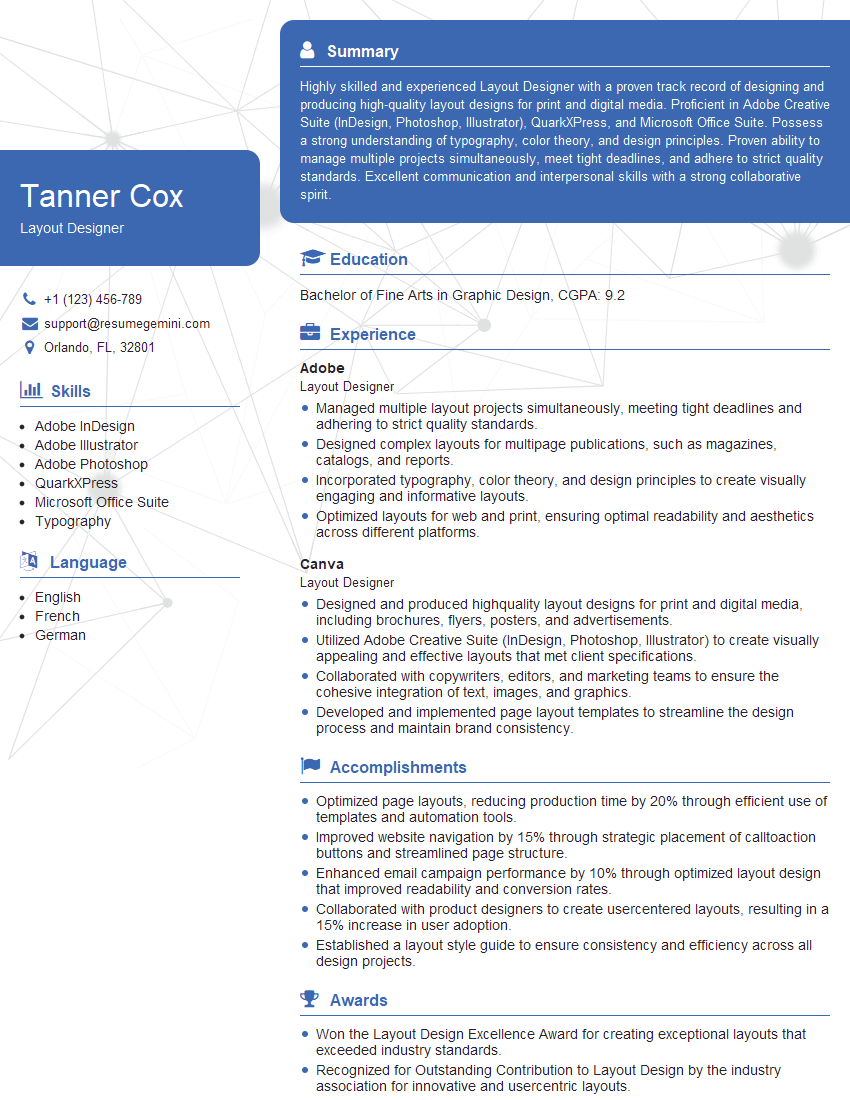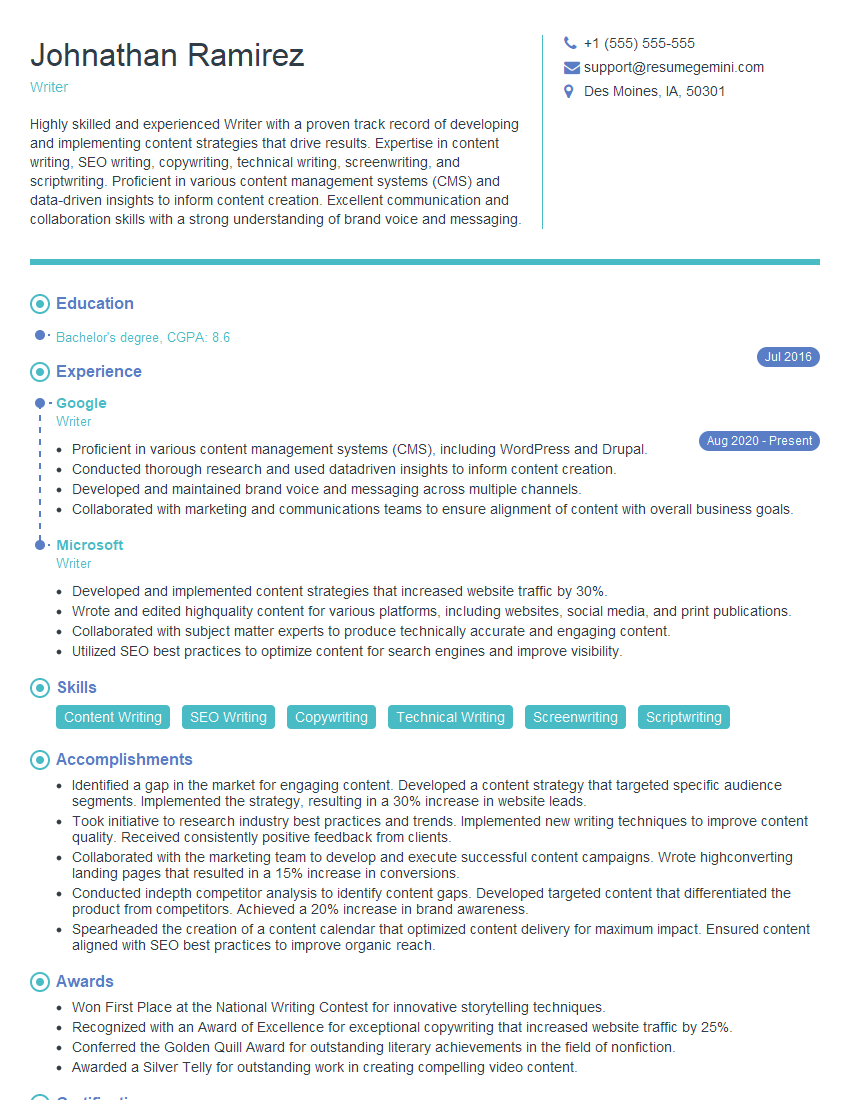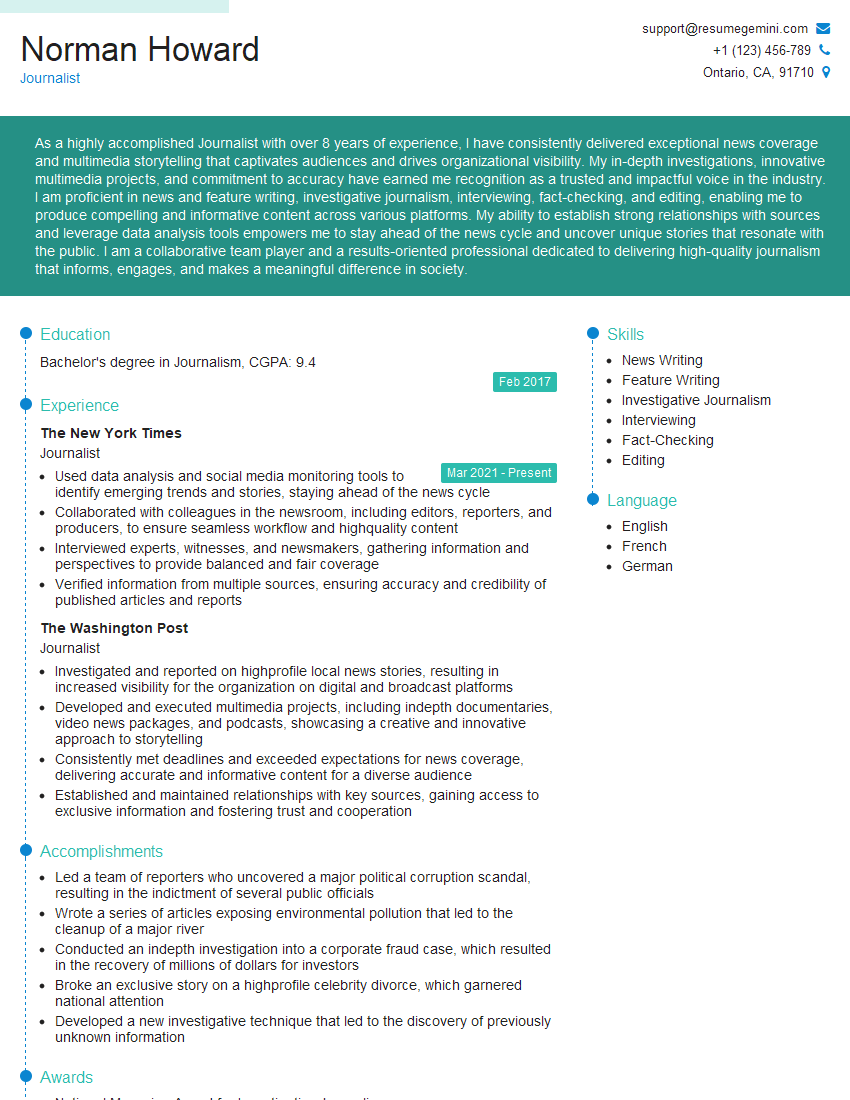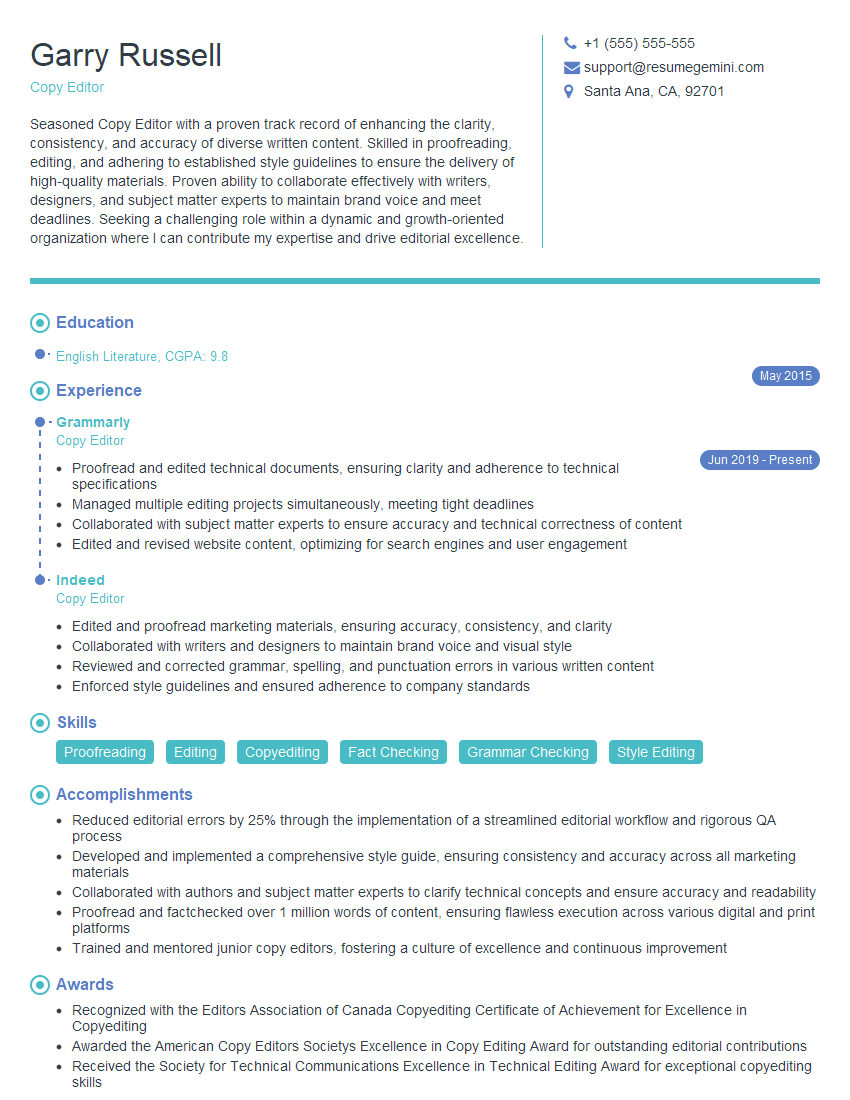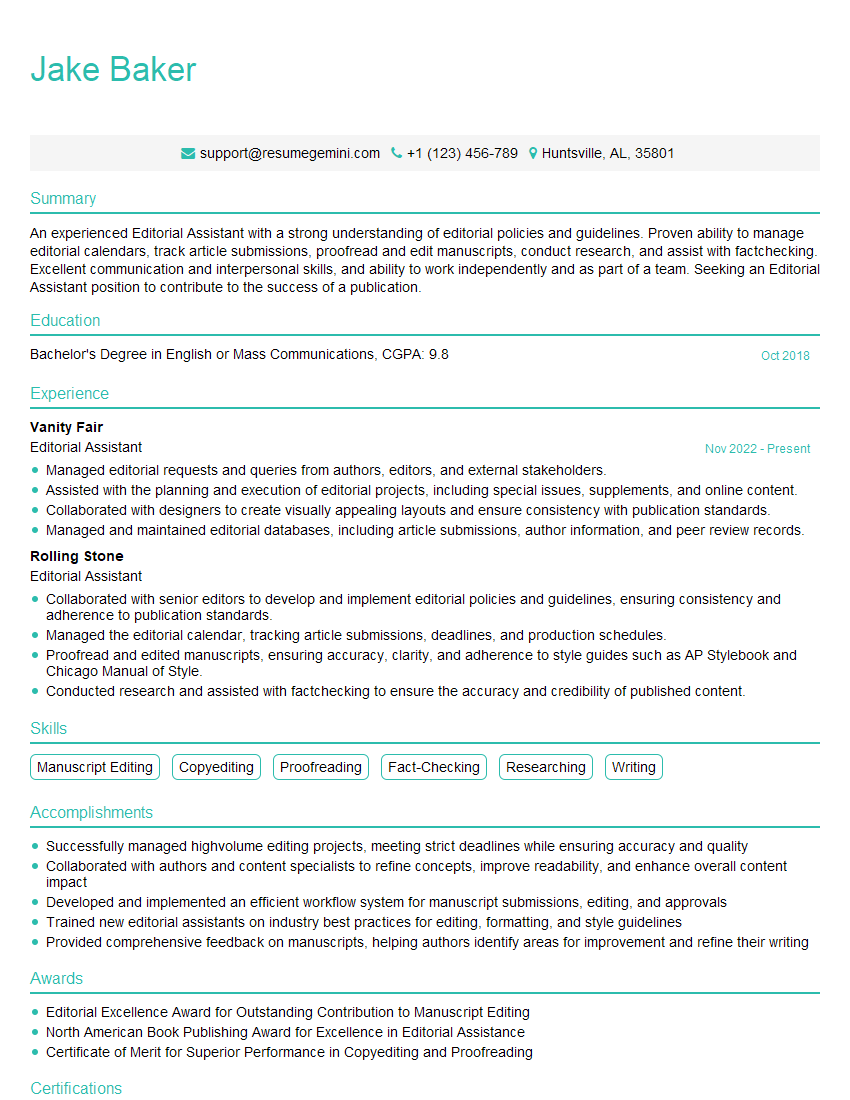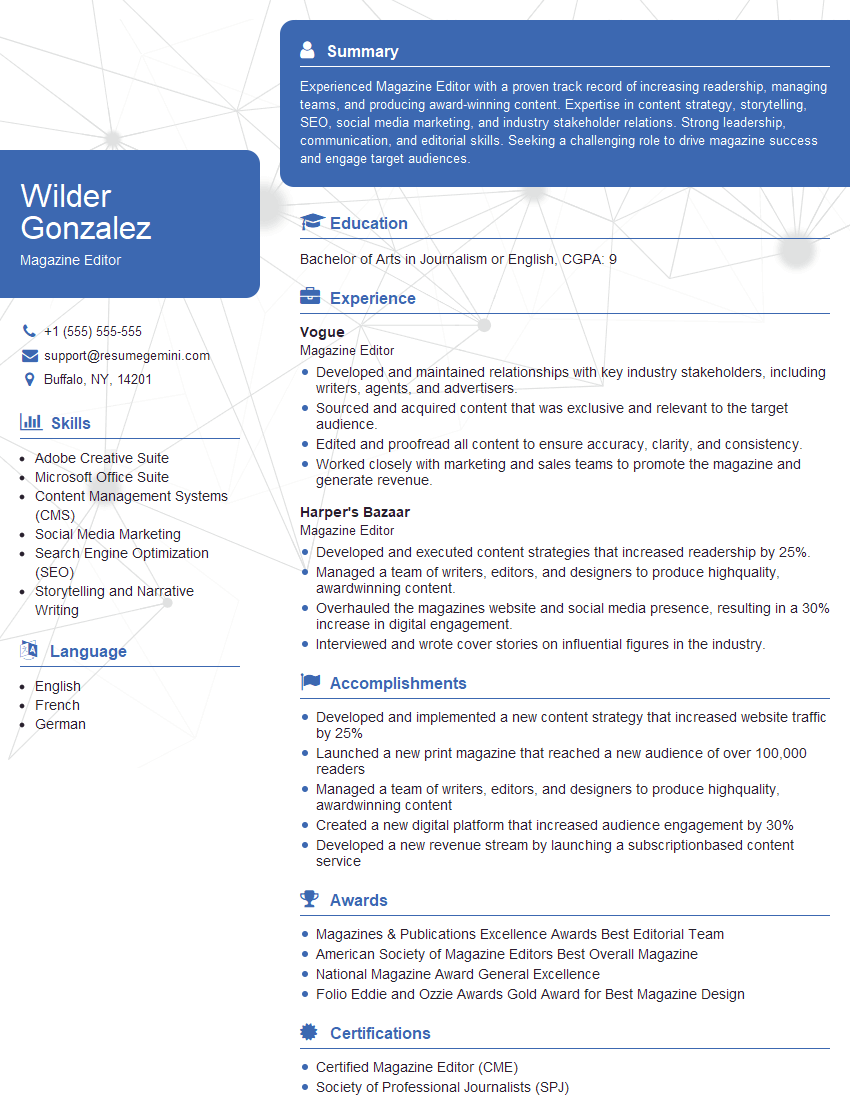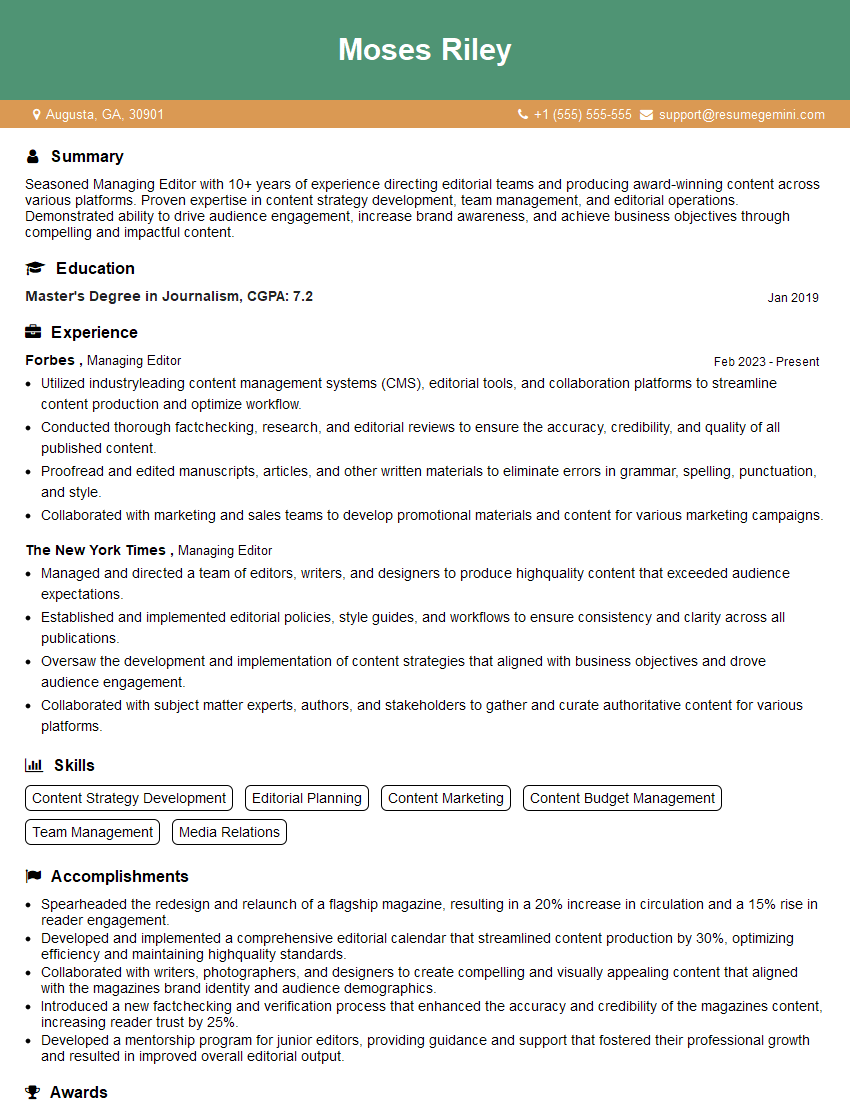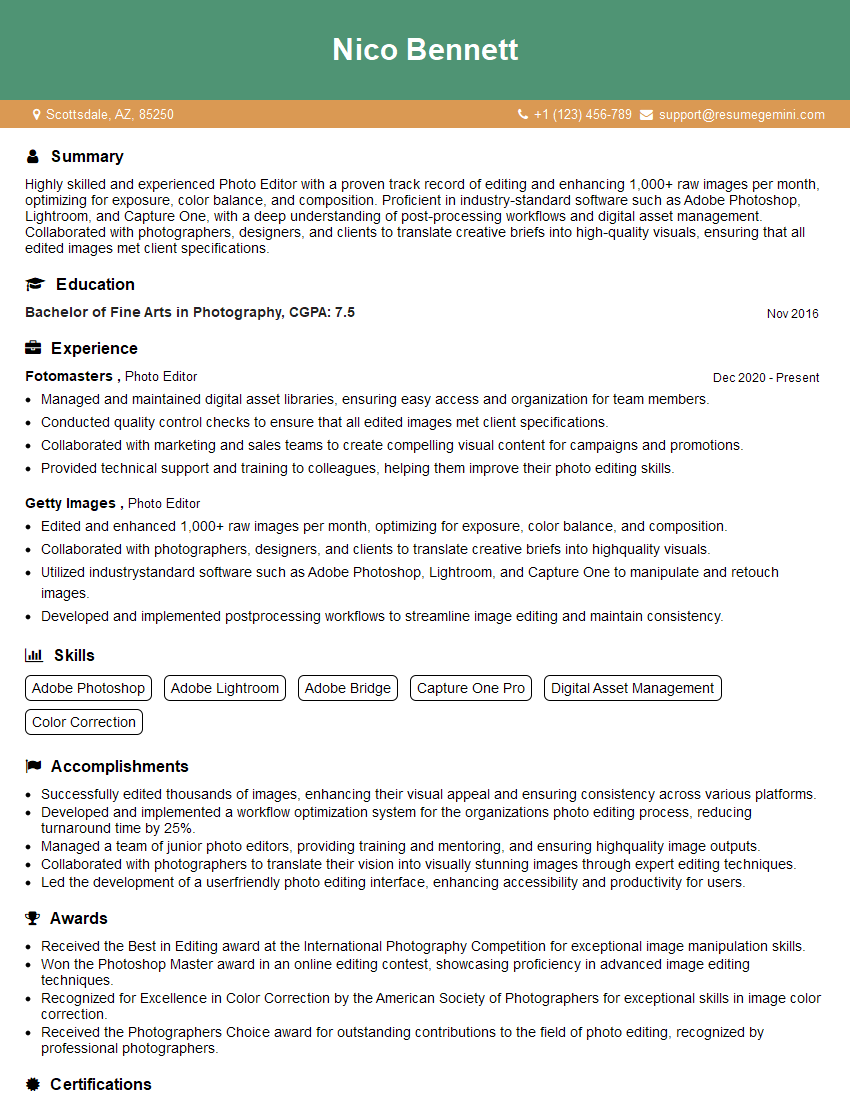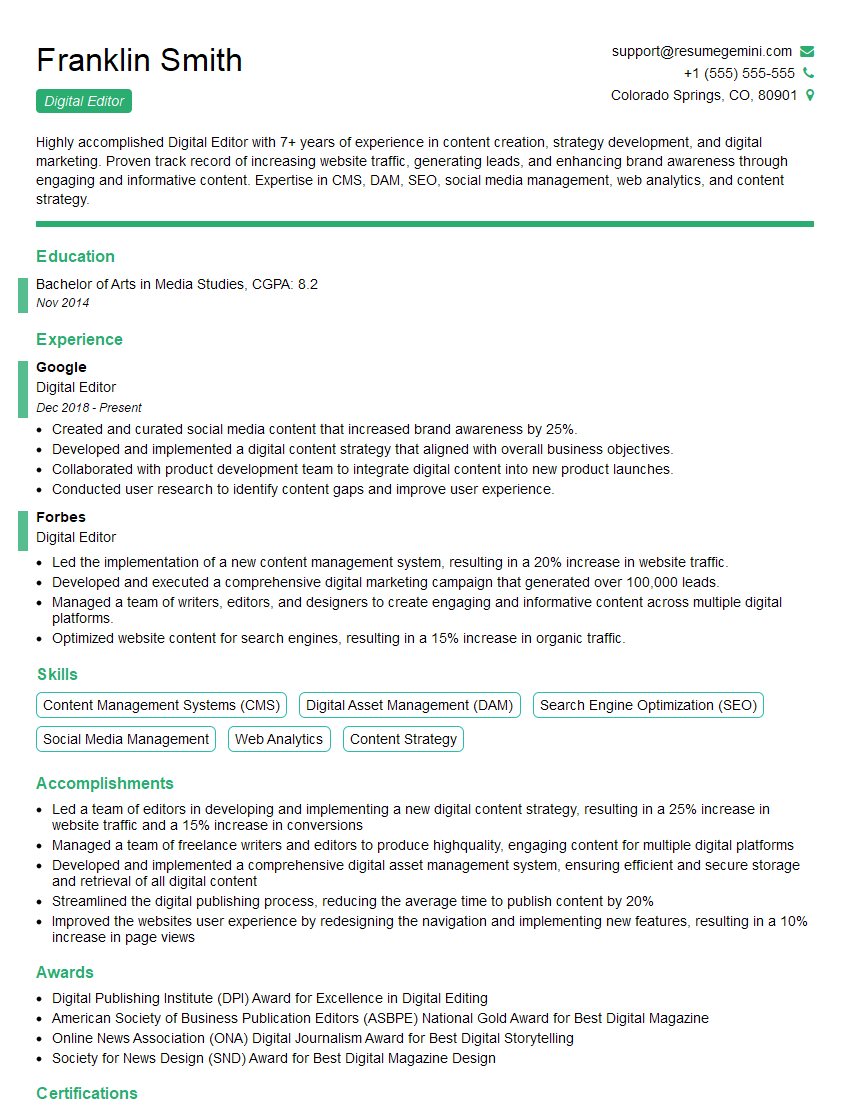Feeling uncertain about what to expect in your upcoming interview? We’ve got you covered! This blog highlights the most important Magazine Publishing interview questions and provides actionable advice to help you stand out as the ideal candidate. Let’s pave the way for your success.
Questions Asked in Magazine Publishing Interview
Q 1. Describe your experience with content calendar management.
Content calendar management is the backbone of efficient magazine publishing. It’s a strategic plan outlining all editorial content, its publication dates, and the assigned team members. Think of it as a roadmap for the entire magazine’s production cycle.
My approach involves using a collaborative digital calendar (like Google Calendar or Asana) to meticulously schedule articles, photo shoots, interviews, and design deadlines. This ensures a smooth workflow, prevents content clashes, and allows for proactive resource allocation. For instance, I’ll schedule fact-checking two weeks before a publication deadline, allowing ample time for corrections and revisions. I also include buffer time to account for unforeseen delays. We use color-coding to visually represent different stages of article production (e.g., green for completed writing, yellow for editing, red for pending fact-checking).
- Detailed task assignments: Each entry clearly states who is responsible for what.
- Version control: The calendar notes the current version of each article to avoid confusion.
- Regular review and updates: The team regularly reviews and updates the calendar to reflect any changes or delays.
Q 2. How do you manage competing deadlines in a fast-paced publishing environment?
Juggling multiple deadlines in publishing is a constant challenge, but effective prioritization and communication are key. I employ a triage system, prioritizing tasks based on urgency and impact. A critical feature article nearing its deadline takes precedence over a smaller sidebar piece.
I use a Kanban board (both physical and digital) to visualize the workflow and identify potential bottlenecks. This allows me to redistribute tasks if needed and ensures transparency for the entire team. Regular team meetings, where we openly discuss challenges and adjust deadlines if necessary, are crucial. Open communication prevents unexpected delays and builds teamwork. For example, if a photographer’s delivery is delayed, we immediately adjust the layout schedule and inform the relevant team members.
Furthermore, effective time management techniques such as the Pomodoro Technique help me focus intensely on specific tasks. Regular breaks prevent burnout and maintain productivity.
Q 3. Explain your approach to fact-checking and verifying sources.
Fact-checking and source verification are paramount to maintain credibility. My approach is multi-layered and rigorous. It starts with evaluating the source’s reputation and authority. Is it a reputable news agency, academic journal, or government report? We meticulously check all statistics, dates, and names against multiple independent sources.
For sensitive or controversial information, we cross-reference with several sources to ensure accuracy. We carefully review any quotes or paraphrases to ensure they are accurately represented. Our process is documented, allowing us to easily trace back our verification steps if needed. We employ fact-checking software where relevant to assist with the process and flag potential inconsistencies. If we can’t verify information, it’s either heavily qualified or excluded. Remember, maintaining journalistic ethics is paramount.
Q 4. What software are you proficient in for magazine layout and design?
I’m proficient in Adobe InDesign, Adobe Illustrator, and Adobe Photoshop. InDesign is my primary tool for magazine layout and pagination; it’s the industry standard for a reason. Illustrator is invaluable for creating or editing vector graphics, and Photoshop is crucial for image manipulation and retouching.
I’m also familiar with QuarkXPress, though InDesign is my preferred choice due to its superior features and collaboration tools. My experience extends beyond mere proficiency; I can create intricate layouts, master typography, and effectively manage image placement and resolution across print and digital formats. For example, I’m skilled at creating responsive designs that adjust seamlessly to different screen sizes for the digital version of the magazine.
Q 5. How do you handle disagreements with other team members regarding editorial content?
Disagreements are inevitable in any collaborative environment. My approach emphasizes respectful dialogue and collaborative problem-solving. I believe in fostering an open environment where everyone feels comfortable voicing their opinions.
When disagreements arise, I encourage open discussion, focusing on the merits of each argument rather than personalities. I facilitate a brainstorming session where we explore different perspectives and potential solutions. We often refer to the magazine’s style guide and editorial policies to help resolve differences. Ultimately, the goal is to reach a consensus that best serves the magazine’s vision and journalistic integrity. If a consensus isn’t possible, I’ll present the different viewpoints to the editor-in-chief for a final decision.
Q 6. Describe your experience with image editing and selection.
Image selection and editing are crucial for a magazine’s visual appeal and storytelling. I have extensive experience in selecting high-quality images that align with the publication’s aesthetic and the article’s content. This involves understanding resolution requirements, color palettes, and visual storytelling.
My editing skills encompass using Photoshop for retouching, color correction, and resizing images. I’m adept at manipulating images while maintaining a natural and realistic look, avoiding over-processing. I understand the importance of image licensing and copyright, always ensuring we have the necessary permissions. For example, I carefully select images that complement the text, ensuring they enhance the narrative rather than distracting from it.
Q 7. How do you ensure brand consistency across all magazine content?
Maintaining brand consistency is vital for creating a recognizable and trustworthy publication. This involves establishing clear guidelines and adhering to them throughout all aspects of the magazine’s content. We have a comprehensive style guide that covers everything from typography and color palettes to image usage and tone of voice.
These guidelines are shared with all team members, and we regularly review and update them to maintain relevance. We use templates for articles and layouts to ensure consistency across different issues. This ensures a unified visual identity, reinforcing the magazine’s brand and enhancing reader recognition. For instance, specific fonts, colors, and image styles are used consistently, creating a coherent experience for the reader.
Q 8. What strategies do you use to increase magazine readership or digital engagement?
Increasing magazine readership and digital engagement requires a multi-pronged strategy focusing on content, distribution, and audience interaction. It’s like building a loyal community around your publication.
Content Strategy: High-quality, relevant content is paramount. This involves understanding your target audience’s needs and interests through market research and analytics. For example, if your magazine focuses on sustainable living, you might commission articles on eco-friendly products, zero-waste living tips, and interviews with sustainability leaders. Diversifying content formats (e.g., video interviews, podcasts, interactive quizzes) can also significantly boost engagement.
Distribution and Promotion: Simply creating great content isn’t enough; you need to get it in front of the right people. This involves leveraging social media marketing, email newsletters, search engine optimization (SEO), and collaborations with influencers relevant to your niche. For instance, partnering with a popular environmental blogger to promote an article on sustainable fashion can significantly expand your reach.
Audience Engagement: Foster a sense of community by actively interacting with your readers. Encourage comments and feedback on your articles, run contests and giveaways, and create opportunities for readers to connect with each other (e.g., online forums). Responding to comments and incorporating reader feedback demonstrates that you value their opinions, making them feel heard and appreciated.
Data Analytics: Regularly analyze website traffic, social media engagement, and subscription data to understand what resonates with your audience and what needs improvement. This data-driven approach allows for iterative improvements to your strategy.
Q 9. How familiar are you with AP style or other editorial style guides?
I am very familiar with AP style and other editorial style guides, including Chicago Manual of Style and MLA. Consistency in style is critical for professional publications. It ensures clarity, readability, and credibility. My experience encompasses applying these style guides to various content formats, from print articles to online blog posts and social media updates. Understanding these guides allows me to ensure accuracy in grammar, punctuation, capitalization, and formatting, contributing to the overall professionalism and integrity of the publication.
Q 10. Explain your understanding of copyright and usage rights for images and text.
Copyright and usage rights are crucial in magazine publishing. Understanding these protects both the publication and its contributors. Copyright protects original works of authorship, including text, images, and graphics. Using copyrighted material without permission is infringement. Usage rights specify how a work can be used – for example, exclusive rights grant the publisher sole use, while non-exclusive rights allow the creator to license the work to multiple parties. Always obtaining proper permissions before using images or text is vital to avoid legal issues and maintain ethical standards.
For images, this often involves purchasing licenses from stock photography sites or obtaining permission directly from photographers. For text, it might involve securing reprint permissions from the original publisher or author. Proper attribution and crediting are essential components of respecting copyright and maintaining transparency.
Q 11. How do you prioritize tasks and manage your workload efficiently?
Effective task prioritization and workload management are essential in magazine publishing, where deadlines are tight and multiple projects often run concurrently. I utilize a combination of techniques:
Prioritization Matrices: Tools like Eisenhower Matrix (urgent/important) help me categorize tasks based on their urgency and importance. This ensures that critical tasks are tackled first, while less urgent ones are scheduled accordingly.
Project Management Software: Software like Asana or Trello allows me to create detailed project timelines, assign tasks to team members, track progress, and manage deadlines effectively.
Time Blocking: I allocate specific time blocks for different tasks throughout the day. This improves focus and prevents multitasking, which can reduce efficiency.
Regular Planning and Review: Weekly or bi-weekly planning sessions help me anticipate potential roadblocks and adjust my schedule as needed. Regular review sessions ensure that I stay on track and address any emerging issues promptly.
Imagine it like building a house: you wouldn’t start painting the walls before laying the foundation. Similarly, prioritizing essential tasks ensures the successful completion of projects.
Q 12. Describe your experience with budget management in a publishing context.
My experience with budget management in publishing includes creating and managing budgets for both print and digital projects. This involved detailed cost breakdowns for printing, paper stock, design, photography, editorial, marketing, and distribution. I developed detailed budget proposals and tracked expenses meticulously against allocated funds. Finding cost-effective solutions without compromising quality is a key skill. For instance, exploring different printing options or negotiating better rates with vendors can significantly impact the budget. Regular budget reviews and reporting allowed for proactive adjustments to address any discrepancies and prevent overspending.
Q 13. How would you handle a situation where a critical deadline is missed?
Missing a critical deadline is a serious issue, requiring immediate action and open communication. The first step is to assess the reasons for the delay and identify the extent of the impact. Then, I would:
Inform Stakeholders: Immediately notify relevant team members, editors, and potentially the publisher, explaining the situation honestly and transparently.
Develop a Recovery Plan: Collaborate with the team to create a revised schedule, identifying potential solutions to catch up. This may involve prioritizing certain sections, re-allocating resources, or extending the timeline for less critical elements.
Implement Corrective Measures: Determine the root cause of the delay to prevent similar incidents in the future. This may involve addressing workflow inefficiencies, improving communication, or providing additional training to team members.
Mitigate Damage: Address any negative consequences of the delay, such as notifying subscribers or advertisers about the adjusted publication date.
Open communication and proactive problem-solving are essential to minimize the damage and maintain trust among stakeholders.
Q 14. What is your experience with print production and pre-press processes?
My experience with print production and pre-press processes is extensive. I’m familiar with the entire workflow, from preparing files for print to overseeing the final production. This includes:
File Preparation: Ensuring all files (text, images, graphics) meet the required specifications for printing, including resolution, color profiles, and file formats (e.g., PDF/X-1a).
Proofreading and Quality Control: Thorough proofreading and quality control checks are critical to identify and correct any errors before printing.
Color Management: Understanding and managing color profiles to ensure accurate color reproduction in print.
Working with Printers: Communicating effectively with printers, providing them with the necessary files and information, and overseeing the printing process to ensure quality.
Imposition and Platemaking: Understanding the process of arranging pages for printing (imposition) and the creation of printing plates.
The print production process is like a carefully orchestrated symphony; every element needs to be in perfect harmony to produce a high-quality final product.
Q 15. How do you identify and develop compelling story ideas?
Identifying compelling story ideas is the cornerstone of successful magazine publishing. It’s a blend of intuition, research, and understanding your target audience. My approach involves a multi-pronged strategy:
Trend Spotting: I constantly scan the news, social media, and industry publications to identify emerging trends and significant events that resonate with our readership. For example, noticing a surge in interest in sustainable living could inspire a feature on eco-friendly products or practices.
Audience Research: Understanding reader demographics, interests, and pain points is critical. Analyzing reader surveys, website analytics, and social media engagement provides invaluable insights into what topics will pique their interest. We might find, through analytics, that articles on personal finance are exceptionally popular, leading to a dedicated section on the subject.
Brainstorming Sessions: Regular brainstorming sessions with the editorial team are crucial for generating creative ideas and exploring diverse perspectives. We use techniques like mind mapping and free writing to unlock innovative story concepts. For instance, a brainstorm on “future of work” might lead to articles about remote work, AI’s impact on jobs, or the gig economy.
Expert Consultation: Engaging with industry experts and thought leaders can reveal untold stories and provide unique perspectives. A conversation with a renowned economist might uncover a compelling angle on the global financial climate.
Once an idea sparks, rigorous fact-checking and feasibility assessments are conducted before greenlighting the story.
Career Expert Tips:
- Ace those interviews! Prepare effectively by reviewing the Top 50 Most Common Interview Questions on ResumeGemini.
- Navigate your job search with confidence! Explore a wide range of Career Tips on ResumeGemini. Learn about common challenges and recommendations to overcome them.
- Craft the perfect resume! Master the Art of Resume Writing with ResumeGemini’s guide. Showcase your unique qualifications and achievements effectively.
- Don’t miss out on holiday savings! Build your dream resume with ResumeGemini’s ATS optimized templates.
Q 16. Describe your approach to conducting interviews with sources.
Conducting interviews is an art form in itself. My approach centers on building rapport, thorough preparation, and active listening. Before an interview, I meticulously research the source and formulate targeted questions to elicit insightful responses. I aim for a conversational tone, making the interviewee feel comfortable and encouraging them to share their expertise freely.
Preparation: I thoroughly research the interviewee and the topic, creating a detailed list of questions covering all relevant aspects. This shows respect for the interviewee’s time and ensures a productive session.
Active Listening: I focus on actively listening to the responses, rather than simply waiting for my turn to speak. This allows me to follow up with insightful probing questions based on what the interviewee says, leading to richer, more nuanced answers. For instance, if they mention a challenge, I’ll ask follow-up questions like, “Can you tell me more about how you overcame that challenge?”
Building Rapport: Creating a comfortable atmosphere is key. Starting with friendly conversation helps the interviewee relax and share openly. Showing genuine interest in their perspective builds trust.
Verification: After the interview, I always verify the information gathered from multiple sources to ensure accuracy. This may include referencing official documents, cross-checking with other experts, or fact-checking statements made by the interviewee.
The entire process aims to obtain accurate, compelling quotes and information that enriches the article’s narrative.
Q 17. How do you ensure the accuracy and quality of the magazine’s content?
Ensuring accuracy and quality is paramount. We employ a rigorous multi-step process:
Fact-Checking: Every piece of information, from statistics to quotes, is verified against multiple reputable sources. We use a combination of online databases, academic research, and primary sources to ensure the accuracy of our claims.
Multiple Sources: We rely on multiple sources to avoid bias and to paint a comprehensive picture of the subject matter. We aim for a diversity of opinions and perspectives.
Copy Editing & Proofreading: The editorial team meticulously reviews the content for grammar, spelling, style, and factual accuracy. Several rounds of editing are conducted before publication.
Internal Review: The final version is reviewed by the editor-in-chief and other senior editors to ensure it meets the magazine’s standards for quality and accuracy. This offers another layer of quality control.
External Review (for sensitive topics): For particularly sensitive topics or in-depth investigations, we may seek external review by subject-matter experts to validate the findings and maintain journalistic integrity. For example, before publishing an article on complex medical procedures, we would consult with medical professionals to ensure the information is accurate and not misleading.
This layered approach minimizes errors and strengthens the magazine’s credibility.
Q 18. How familiar are you with different magazine formats (e.g., print, digital, online)?
I have extensive experience working with various magazine formats – print, digital, and online. I understand the unique requirements and challenges of each:
Print: Print magazines require careful consideration of page layout, typography, and image quality. The focus is on creating a visually appealing and engaging experience that readers can physically interact with. This often involves working closely with designers and graphic artists.
Digital (e.g., PDFs, e-magazines): Digital magazines allow for interactive elements, hyperlinks, and multimedia integration. The design needs to be optimized for various devices and screen sizes, ensuring a smooth reading experience across platforms. This necessitates an understanding of different file formats and digital publishing platforms.
Online (website, blog): Online formats are highly dynamic, requiring responsive design, SEO optimization, and effective social media integration. The content needs to be easily searchable, easily shareable, and updated frequently to maintain reader engagement. It’s crucial to understand website analytics and user behavior to optimize content delivery.
My expertise spans across all these formats, allowing me to tailor content and design to the specific requirements of each platform while maintaining a consistent brand voice.
Q 19. What is your experience with SEO optimization for magazine content?
I’m highly familiar with SEO (Search Engine Optimization) principles and their application to magazine content. My approach involves:
Keyword Research: I use keyword research tools to identify relevant keywords and phrases that readers use to search for information related to our magazine’s content. This helps us to optimize articles for search engines.
On-Page Optimization: This involves optimizing the article’s title, headings, meta descriptions, and image alt text to include relevant keywords. It also includes ensuring the content is well-structured, easy to read, and provides valuable information for the reader.
Off-Page Optimization: This involves building high-quality backlinks from reputable websites to increase the article’s authority and ranking in search results. This includes outreach to relevant bloggers and publications, and strategic guest posting.
Content Strategy: We develop a content strategy that aligns with the magazine’s editorial calendar and SEO goals. This involves identifying target keywords and themes, and creating content that satisfies both reader needs and SEO best practices. For instance, a focus on long-tail keywords allows for more specific and relevant content.
I monitor website analytics to track the performance of our SEO efforts and make data-driven adjustments to improve our rankings and visibility. We use tools like Google Analytics and Search Console to track key metrics such as organic traffic and keyword rankings.
Q 20. How would you adapt content for different digital platforms?
Adapting content for different digital platforms requires a nuanced understanding of each platform’s audience, technical capabilities, and user experience. My approach considers several key aspects:
Content Formatting: Different platforms have varying optimal formats. For example, Twitter requires concise, impactful messaging, while a blog post allows for longer, more detailed content. Facebook might benefit from visually engaging content like images and videos.
Content Length & Style: The ideal length and style of content vary greatly depending on the platform. For instance, Instagram captions are typically short and punchy, while a LinkedIn article can be more formal and in-depth.
Multimedia Integration: Platforms like Instagram and YouTube thrive on visually rich content, so integrating relevant images, videos, and other multimedia elements is crucial. However, this needs to be tailored to the platform’s guidelines and the audience’s preferences. For example, using vertical videos on Instagram reels.
Platform-Specific Optimization: Understanding and optimizing content for each platform’s unique algorithm is essential for maximizing reach and engagement. This involves using relevant hashtags, tagging relevant accounts, and understanding the best times to post.
Adapting content effectively across various digital platforms increases reach and ensures that the message is effectively delivered to a broader audience, maintaining consistency while catering to the individual preferences of each platform’s users.
Q 21. Describe your experience with social media marketing for a magazine.
My experience with social media marketing for magazines involves a strategic and data-driven approach. It’s not just about posting content; it’s about building a community and driving engagement:
Content Strategy: We develop a social media content calendar that aligns with the magazine’s editorial calendar and marketing goals. This involves creating a mix of content formats (images, videos, stories, live streams) to maintain reader engagement and appeal to the different preferences of each platform.
Community Building: We actively engage with our followers, responding to comments and questions, and fostering a sense of community around the magazine’s content. This could involve running Q&A sessions, polls, or contests to encourage interaction.
Paid Advertising: We utilize paid social media advertising to reach a wider audience and promote specific articles or features. We target our ads based on demographics, interests, and behaviors to optimize campaign performance.
Analytics & Tracking: We meticulously track key metrics, such as engagement rate, reach, website traffic, and conversion rates, to assess the effectiveness of our social media efforts and inform future strategies. This includes using platform-specific analytics tools as well as external analytics platforms for a holistic view.
By combining creative content creation with data-driven analysis and a focus on community building, we can effectively leverage social media to expand the magazine’s reach and increase its influence.
Q 22. How do you measure the success of a magazine publishing project?
Measuring the success of a magazine publishing project goes beyond simply looking at the number of copies sold. It’s a multifaceted process requiring a balanced approach to various key performance indicators (KPIs). We use a combination of quantitative and qualitative metrics.
Quantitative Metrics: These are easily measurable and include circulation figures (both print and digital subscriptions), advertising revenue, website traffic (unique visitors, page views, time on site), social media engagement (likes, shares, comments), and download rates for digital editions. For example, a significant increase in digital subscriptions alongside strong web traffic indicates a successful transition to a multi-platform approach.
Qualitative Metrics: These provide deeper insights into reader satisfaction and brand perception. We track reader feedback through surveys, social media monitoring, and focus groups. Positive reviews, high reader retention rates, and strong brand recognition all signify success. For instance, consistently positive reader feedback on a specific column or feature can inform future content strategy.
Financial Metrics: Profitability is crucial. We analyze revenue streams (subscriptions, advertising, events, etc.) against operational costs (printing, editorial salaries, distribution, marketing) to determine overall financial health. A healthy profit margin demonstrates sustainable success.
By combining these different metrics, we gain a holistic view of the project’s performance and make data-driven decisions for improvement and future planning.
Q 23. What are your thoughts on the future of magazine publishing?
The future of magazine publishing is dynamic and exciting, characterized by a shift towards digital platforms and diversified revenue streams. Print isn’t disappearing entirely; it’s evolving into a more specialized, premium product. I see a future where:
Digital Dominance: Digital editions, apps, and websites will continue to grow in importance, providing opportunities for interactive content, targeted advertising, and personalized reader experiences. We’ll likely see more sophisticated forms of digital storytelling, incorporating video, augmented reality, and interactive infographics.
Niche Audiences: Hyper-specialized magazines focusing on specific demographics or interests will thrive, offering curated content to deeply engaged readers. The ability to reach niche markets through targeted digital advertising becomes increasingly crucial.
Diversified Revenue Models: Magazines will explore new revenue avenues beyond traditional print subscriptions and advertising. This includes events, memberships, e-commerce, and sponsored content, creating a broader base of financial stability.
Data-Driven Content: Utilizing data analytics to understand reader preferences will become even more critical in shaping editorial content and marketing strategies. Personalization will be key to enhancing reader experience and engagement.
Essentially, the future is about agility, innovation, and a reader-centric approach that embraces diverse platforms and revenue models. The magazines that adapt to these changes will be the ones that flourish.
Q 24. How do you stay updated on industry trends and best practices?
Staying current in the fast-paced magazine publishing world requires a multi-pronged approach.
Industry Publications and Websites: I regularly read trade publications like Folio: and Editor & Publisher, as well as relevant online resources to keep up with the latest industry trends, news, and best practices. These publications often feature case studies and success stories which provide practical insights.
Conferences and Workshops: Attending industry conferences like the ASME or MPA events provides invaluable networking opportunities and access to the latest research and innovative techniques. These events allow for direct interaction with peers and industry leaders.
Professional Organizations: Membership in relevant professional organizations like the American Society of Magazine Editors (ASME) offers access to resources, webinars, and networking opportunities. These organizations also provide platforms for discussions and debates about industry challenges and trends.
Competitor Analysis: I regularly analyze the content and strategies of leading magazines, both within our niche and beyond, to identify best practices and innovative approaches. Studying competitors’ strategies and outcomes is an effective way to improve one’s own approach.
This combination of information gathering allows me to continuously refine my understanding of the market and adapt my strategies accordingly.
Q 25. Explain your experience with audience analytics and data interpretation.
Audience analytics and data interpretation are integral to my approach. We leverage various tools to collect and analyze data, allowing for data-driven decision-making.
Website Analytics: Tools like Google Analytics provide detailed information on website traffic, user behavior, and content performance. This helps us understand which articles are most popular, where our audience is coming from, and how they are engaging with our content.
Social Media Analytics: We track social media engagement to understand which platforms are most effective for reaching our target audience, as well as sentiment analysis of social media mentions to gauge reader opinions and brand perception. This allows for optimized social media posting schedules and improved brand messaging.
Subscription and Sales Data: Analysis of subscription rates, renewal rates, and sales data provides insights into audience demographics, preferences, and purchasing behaviors. This data guides our marketing efforts and allows for targeted subscription campaigns.
Reader Surveys and Feedback: We use surveys to gather direct feedback from readers, understanding their satisfaction levels, content preferences, and areas for improvement. This directly improves the magazine’s content and caters better to the readers’ needs.
Interpreting this data involves identifying trends, patterns, and anomalies that can inform editorial decisions, marketing strategies, and overall publication development. For instance, if analytics show a significant drop in engagement with a specific section of the magazine, we can investigate the reasons and adjust accordingly. The goal is always to create a more relevant and engaging magazine.
Q 26. Describe your approach to working with freelance writers or contributors.
Working effectively with freelance writers and contributors requires a collaborative and respectful approach that values both creativity and efficiency.
Clear Communication: I provide detailed briefs that clearly outline the article’s purpose, scope, target audience, desired tone, and style guide. This ensures everyone is on the same page from the outset.
Contractual Agreements: All freelance work is based on a clear contract, specifying deliverables, deadlines, payment terms, and intellectual property rights. This ensures clarity and prevents misunderstandings.
Regular Feedback: I maintain regular communication throughout the writing process, offering constructive feedback and answering any questions promptly. This fosters a collaborative environment and enhances the quality of the final product.
Prompt Payments: Timely payments are crucial for maintaining positive relationships with freelancers and ensuring consistent high-quality work. It’s a matter of professionalism and respect for their contribution.
Building Relationships: I prioritize building long-term relationships with talented freelance writers, creating a reliable pool of contributors we can count on for high-quality work.
By establishing a system of clear communication, fair compensation, and mutual respect, I ensure positive and productive working relationships with freelance writers.
Q 27. How would you respond to negative feedback about the magazine’s content?
Negative feedback, while sometimes challenging, is invaluable for improvement. My response involves a multi-step process:
Acknowledge and Validate: I begin by acknowledging the feedback and validating the reader’s feelings. Even if I don’t agree with all aspects of the criticism, I demonstrate empathy and understanding.
Analyze and Investigate: I analyze the feedback to identify the underlying issues. Is the criticism about the content itself, the writing style, the design, or something else? We might conduct further research to understand the broader context of this feedback.
Respond Appropriately: Depending on the nature of the feedback, I may respond directly to the reader, publish a clarification or correction, or use the feedback to inform future editorial decisions. A public response shows the reader that their voice matters.
Implement Changes (If Necessary): If the negative feedback points to systemic issues, such as a recurring problem with a specific writer or a weakness in a certain area of coverage, I make the necessary changes to address these concerns and improve future publications.
The goal is to transform negative feedback into opportunities for growth and improvement, demonstrating a commitment to quality and reader satisfaction.
Q 28. How do you balance creative vision with business considerations in magazine publishing?
Balancing creative vision with business considerations is a constant tightrope walk in magazine publishing. It’s about finding the sweet spot where artistic integrity meets financial viability.
Market Research: Thorough market research helps identify reader preferences and market trends. This provides a business-driven framework for creative decisions. We can align creative vision with actual reader demand.
Data-Informed Decisions: Analyzing data on readership, advertising revenue, and website traffic allows us to make informed decisions that align creative choices with business goals. Data helps justify creative risks by showing their potential returns.
Budgeting and Resource Allocation: Developing a realistic budget ensures that creative ambitions are tempered by financial constraints. This forces prioritization and ensures responsible spending.
Collaboration: Open communication and collaboration between the editorial team, the sales team, and the marketing team ensure that creative vision is aligned with business goals. This shared understanding prevents conflicting priorities.
Iterative Approach: We adopt an iterative process where initial creative concepts are tested and refined based on reader feedback and business performance. This allows for flexibility and adaptability.
Ultimately, it’s about creating a magazine that is both creatively satisfying and financially sustainable. This requires constant dialogue, careful planning, and a willingness to adapt to changing circumstances.
Key Topics to Learn for Magazine Publishing Interview
- Editorial Process: Understanding the entire lifecycle of a magazine, from concept to publication, including pitching, fact-checking, editing, and proofing.
- Content Strategy & Planning: Developing editorial calendars, identifying target audiences, and creating compelling content plans that align with publication goals.
- Visual Communication & Design: Understanding the importance of layout, typography, and imagery in conveying a magazine’s message and brand identity. Practical application includes analyzing existing magazine layouts and critiquing their effectiveness.
- Market Research & Analysis: Analyzing readership data, understanding market trends, and using this information to inform editorial strategy and decisions.
- Digital Publishing & Strategy: Familiarity with online magazine formats, content management systems (CMS), and digital marketing strategies for reaching online audiences.
- Publication Management & Production: Understanding the logistical aspects of magazine production, including print production, scheduling, and budget management. Problem-solving might include finding creative solutions for budget constraints without compromising quality.
- Legal & Ethical Considerations: Understanding copyright laws, defamation, and journalistic ethics, and applying them in your editorial work.
- Teamwork & Collaboration: Demonstrating an understanding of working effectively within a team of editors, designers, writers, and other publishing professionals.
Next Steps
Mastering the intricacies of magazine publishing opens doors to a dynamic and rewarding career, offering opportunities for creative expression, strategic thinking, and impactful communication. To maximize your job prospects, it’s crucial to create a resume that effectively showcases your skills and experience to Applicant Tracking Systems (ATS). Building an ATS-friendly resume is paramount in today’s job market. We highly recommend using ResumeGemini, a trusted resource for building professional and impactful resumes. ResumeGemini provides valuable tools and guidance, including examples of resumes tailored specifically to the magazine publishing industry, to help you present yourself in the best possible light.
Explore more articles
Users Rating of Our Blogs
Share Your Experience
We value your feedback! Please rate our content and share your thoughts (optional).
What Readers Say About Our Blog
Interesting Article, I liked the depth of knowledge you’ve shared.
Helpful, thanks for sharing.
Hi, I represent a social media marketing agency and liked your blog
Hi, I represent an SEO company that specialises in getting you AI citations and higher rankings on Google. I’d like to offer you a 100% free SEO audit for your website. Would you be interested?

